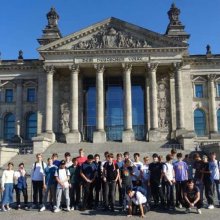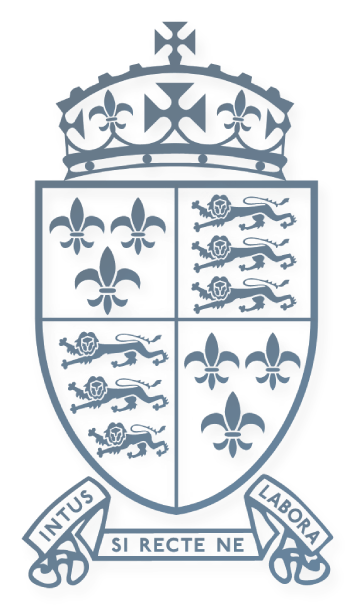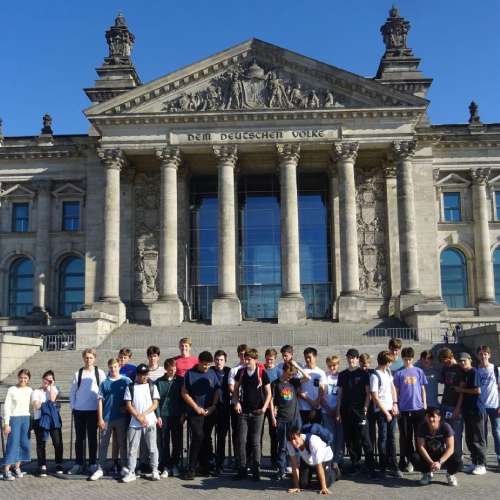Shrewsbury
History Faculty Trip to Berlin - Pupil Diaries


Thanks to Fifth Formers Edward Bayliss, Elizabeth Edwards and Bertie Shepherd-Cross for their thoughtful accounts of their visits to some of the key sites in Berlin's turbulent 20th century history.
Day One:
After an extremely busy half of term, ending with The Tucks and House Singing, 30 pupils and three members of staff had the daunting prospect of a 3.00am start for our history trip to Berlin. However, on our arrival the weather was unbelievably good, with cloudless skies; quite the opposite of the hurricane-like conditions we had left behind in Shrewsbury.
Our first day was spent taking a walking tour of the city centre, starting with the German Chancellery, located near the River Spree. We then saw the Reichstag – an outstanding structure built in 1894 for the German People (as inscribed on the building itself ‘Dem Deutschen Volke’).
Walking through the Tiergarten park, we visited a memorial to the Sinti and Roma (those who were murdered under National Socialism): a circular, reflecting pool with a triangular stone at the centre representing the triangle patches that prisoners were required to wear at the Nazi concentration camps. En route to the Soviet War Memorial, the streets were bustling with people since an LGBT parade was being held – one of Europe’s largest street parties, which really encapsulated the vibrant city culture of Berlin.
After a short break in the Mall of Berlin, we made our way to the Topography of Terror. On the way, we saw a classic example of Nazi architecture: the former Reich Air Ministry. Constructed between 1935 and 1936, it was the largest office building in Europe at the time that handled military aviation matters, particularly for the Luftwaffe.
Once we had looked around the Topography of Terror, a museum built on the site of the Gestapo and SS headquarters during the Nazi Regime, we headed for our last destination, Checkpoint Charlie. Our busy day was rounded off with an authentic German meal.
Edward Bayliss (Rt)
.jpg)
Day Two:
We began our second day by visiting the Sachsenhausen concentration camp. The short drive just outside of Berlin brought us to the gates of the camp where Rob, our tour guide, explained to us the history of the camp. We were able to enter the restored huts where the inhabitants of the camp would have stayed. Rob gave us a detailed explanation of every component of the camp which helped us get a sense of the scale of the operation.
We then made the brief journey to the Berlin Olympic Stadium of 1936. We circled the stadium, stopping often to listen to Rob, who described the events that took place in this stadium and the political statement that the stadium provided at its construction. We were able to view the interior of the stadium as well.
.jpg)
Next, we visited the location of the Wannsee Conference, or the ‘Final Solution to the Jewish question’, which took place in January 1942. The house where the meeting was held now acts as a museum. We looked round the museum as well as listening to Rob, who explained to us in detail the specifics of the Wannsee Conference.
The penultimate location we visited was ‘Gleis 17’ at Grunewald Station. This was one of the main deportation points for Jews in Berlin. The site has been transformed into a memorial and contains the dates of each transportation and how many Jews were deported on that train.
Finally, we visited the Reichstag in the evening where we scaled the newly installed dome to see the layout of Berlin. We also learned of the importance of the Reichstag in German politics and how the Reichstag fire - an arson attack on the building in February 1933 - allowed Hitler to gain power. We ended our busiest day by eating out and travelling back to our B&B for a good night’s sleep!
Elizabeth Edwards (EDH)
Day 3:
The third day of the trip focused predominantly on the Cold War aspect of life in Berlin and the consequences that come with such a divided and opposed city’s history. After an early start we took public transport to Bernauer Strasse where we visited the Berlin Wall Memorial. The simplified and poignant atmosphere struck everyone, as it was a stark reminder of the events in Germany as little as 30 years ago. After much discussion about what side of the wall we were on, we eventually came to the conclusion that we were in fact on neither side but in No Man’s Land. Our guide pointed out to us how buildings were incorporated in the wall in the early years and then torn down to make way for the more substantial wall that followed. The Memorial consisted of rusty metal poles stuck in the ground along the line of the wall which represented the fact that today the wall is very much transparent, but it used to be a fortified border between two totally different regimes.
From the Memorial we had an appointment at the Berlin Hohenschönhausen Memorial: an old soup kitchen for the Nazis during World War II and then a Stasi High Security Interrogation Prison from 1951 until as late as 1990. This, for me, was the most shocking part of the trip. As we were led around the prison, through the corridors and cells which only 30 years ago were used to interrogate political opponents to the East German Regime. I couldn’t help thinking how much more awful it seemed to actually be there and see and feel it.
As we walked through the prison, the sophistication of the techniques used and the organised brutality amazed and moved me particularly. To think that this was happening in our parents’ lifetimes is frankly horrifying. After an eye-opening tour from a professional guide, we had lunch within the walls of the prison and then headed back to the hotel to pick up our bags and drive to the airport where we left our guide and flew home.
The third day of the trip was by no means easy going or light-hearted. However, that said, it was a different perspective of Berlin compared with the previous days. I really enjoyed the diversity of history that one city can produce in the last century. The whole experience was interesting and beneficial, but I would say that the last day was by far the most surprising and reflective.
Bertie Shepherd-Cross (O)






.JPG&command_2=resize&height_2=85)
.jpg&command_2=resize&height_2=85)










